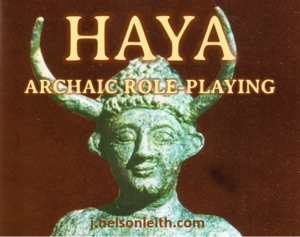 The following key events are measured from the Year of Descent, when the highland ancestors of the Tower People (Yuta) invaded the lands of the mysterious Shore People after one of their tribes (the Wuraso) murdered a princess named Áyakómil. This event is the opening tale of the History of Hokonuwiya, reputed to be the oldest chronicle stone, which recounts the early spread of the Yuta people.
The following key events are measured from the Year of Descent, when the highland ancestors of the Tower People (Yuta) invaded the lands of the mysterious Shore People after one of their tribes (the Wuraso) murdered a princess named Áyakómil. This event is the opening tale of the History of Hokonuwiya, reputed to be the oldest chronicle stone, which recounts the early spread of the Yuta people.
The following events are color-coded by people: Yuta, Adya, Agtile, and Damdilit. Note that the various native words for “chief/monarch” are italicized so you understand they are cross-lingual synonyms. In general the word is waha among the Adya, dhaha among the Damdilit, qatua among the Agtile, yutan among the early Yuta and outer peoples, and etun among the Tudvam, Tydhem, and Etudwa.
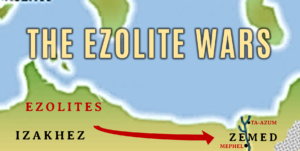 -350 The Ezolite Wars. Bands of Izakhez led by Ezolite giants raid the Stone Age farming clans of of the Kayat valley. The greatest Ezolite warlord Zódad slays the champions of the Zemed and extracts brutal tribute from the clans.
-350 The Ezolite Wars. Bands of Izakhez led by Ezolite giants raid the Stone Age farming clans of of the Kayat valley. The greatest Ezolite warlord Zódad slays the champions of the Zemed and extracts brutal tribute from the clans.
One particularly brutal episode, the Battle of the Inátu Oasis, created a forbidden zone of undead, the Inatu Depression, where the dead arise at nightfall in the thousands to murder any living person foolish enough to be there gathering fresh water or relics from the battle.
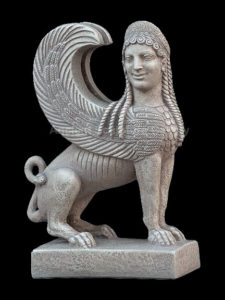 -300 The Five Kingdoms. The Zemed create several Stone Age kingdoms along the river Kayat. At this point, the Shaman of the goddess Agtile and the god Dajata begin spawning androsphinxes and gynosphinxes to help them fight off the Izakhez and Ezolites.
-300 The Five Kingdoms. The Zemed create several Stone Age kingdoms along the river Kayat. At this point, the Shaman of the goddess Agtile and the god Dajata begin spawning androsphinxes and gynosphinxes to help them fight off the Izakhez and Ezolites.
They key relics from this era are the the Obelisks of the Gods, lost stone monuments reputed to be hundreds of feet high (but more likely, according to the most trusted Zemed Scribes, to be about ten feet high) dedicated to the Agtile deities Agtile, Dajata, Adad, and Etadu with the attendant elemental powers.
-250 The Old Dhahayate. The Stone Age peoples of the Nyupam valley unite against the coastal Zhyndh humanoids, and the first dhaha Fasaiza begins building temples and sending traders to nearby peoples.
It is known that the archaic Yuta encounter the Damdalit during the First Dhahayate and learn the stone language logographs from them. The Old Dhahayate have the first Priest and Scribes, who replaced their Shaman and Sorcerors.
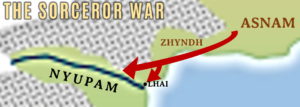 -200 The Sorceror War. Displaced Sorcerors from Nyupam join with Zhyndh humanoids and Asnam quasihumans to raid the Nyupam. During the seige of the port city of Lhai, the dhaha Pasazna is transformed into a sea monster and flees into the waters. This monster, a huge shark with four octopus-like arms, is rumored to still haunt the Tydhem seas south of Damdalit.
-200 The Sorceror War. Displaced Sorcerors from Nyupam join with Zhyndh humanoids and Asnam quasihumans to raid the Nyupam. During the seige of the port city of Lhai, the dhaha Pasazna is transformed into a sea monster and flees into the waters. This monster, a huge shark with four octopus-like arms, is rumored to still haunt the Tydhem seas south of Damdalit.
The invasion ultimately fails, however, all of the invaders slain as they flee to the northeast.
-150 The Squid Raids. Giant squid attack the coastal villages of Yaira, preying on fishermen. The Stone Age Adya ancestors unite behind the waha Sichou and drive back the squid. This results in an island-wide kingdom that establishes ties to Nyupam and adopts their logographs for their own chronicle stones.
 -100 The Adya Expansion from Yaira. The Stone Age Adya ancestors spread north into the unsettled lands of Mijam and Ilomapa under a waha Mijom, and south into Zasai under the waha Vyaza. In Zasai, the armies of Vyaza drive the Red Peyu into the upper Zengulay valley and exterminate the Tsote living along the coasts there.
-100 The Adya Expansion from Yaira. The Stone Age Adya ancestors spread north into the unsettled lands of Mijam and Ilomapa under a waha Mijom, and south into Zasai under the waha Vyaza. In Zasai, the armies of Vyaza drive the Red Peyu into the upper Zengulay valley and exterminate the Tsote living along the coasts there.
-50 The Birth of the Alphabet. The archaic Yuta adapt the Damdalit logographs into an alphabet to use with chronicle stones. This also is the birth of the Poet class, as independent rivals of the Priests and Scribes.
1 The Murder of Áyakómil. A tribe of the Shore People (most likely ancestral Razu) called the Wuraso ambush a royal hunting party from the homeland of the Yuta (most likely Hallia), and kill several Yuta, including the daughter of the yútan.
In response, the Yuta under the yutan Zama, Áyakómil’s father, raid from their highland home and begin subduing the Shore People, driving them to sea in their canoes. This is the event that opens the History of Hokonuwiya, which is widely believed to be the oldest surviving chronicle stone.
100 The Old Banua of Mijam. The Adya people of Mijam unite under a single waha , Kozoi, after a brief war among the clans. Yaira, Jai, Ilomapa, and Huaz, which had been colonize by fishermen, remain independent but establish close ties with Mijam for protection from giant squid.
Many temples to the eight Adya gods, but especially the Fox of Fire Wetawaia, are built by Kozoi during this time.
 200 The Invasion of Wesadhi and Yasayoi. The various waha of Zasai, in a competitive expansion, drive into Tsobikapa (now known as Wesadhi) and Yasayoi. The Tsote of Yasayoi are exterminated, but the Tsote of Tsobikapa retreat into the jungled uplands.
200 The Invasion of Wesadhi and Yasayoi. The various waha of Zasai, in a competitive expansion, drive into Tsobikapa (now known as Wesadhi) and Yasayoi. The Tsote of Yasayoi are exterminated, but the Tsote of Tsobikapa retreat into the jungled uplands.
While the Yasayoi become rogue chiefdoms, the Adya of Tsobikapa (who became the Kaba), set up a thriving civilization of Stone Age city-states on the Zasai model, building elaborate stone temples to the Adya gods.
250 The Ezolite Kingdom. The Ezolite warlord Shosh conquers the Zemed city of Mephel and establishes a kingdom ruled by giants.
The Ezolites use their conquered Priests to build giant stone golems to guard the walls of Mephel.
300 The Victory of the Yuta. As recorded in the History of Hokonuwiya, the archaic Yuta, under the yutan Nómas, finally drive the Shore People out of their lands and begin setting up competing city-states in their former lands.
The warlords of Yuta begin building temples to the Yuta gods along the Hamhes and Wuyira rivers of Vindha, and driving Zhydh humanoids from their lands.
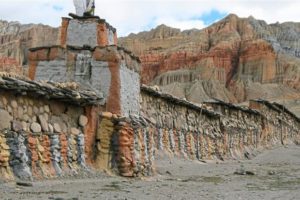 350 The Middle Dhahayate. Zhyndh driven from Vindha by the Yuta invade Nyupam, leading to an era of unrest. Zhyndh and Asnam arise from the northeast to join the displaced Vindhan Zhyndh in harassing the people of Nyupam.
350 The Middle Dhahayate. Zhyndh driven from Vindha by the Yuta invade Nyupam, leading to an era of unrest. Zhyndh and Asnam arise from the northeast to join the displaced Vindhan Zhyndh in harassing the people of Nyupam.
The Nyupam are united behind the dhaha Kamkum, who repels the invaders and establishes the Middle Dhahayate.
400 The First Zemed. The five kingdoms of Zemed unite under a single Zemed qatua, Zamad of Ta-Azum, to drive out the Ezolite warlord Dadúl from Mephel.
The Zemed disperse the Ezolite warbands, shattering the alliance between the giants and the Izakhez, and begin raiding westward, conquering oases and building temples and tombs in the wilderness. The giant stone golems of Mephel are dispersed into the desert of Izakhez, and their eventual fate is unknown to history.
444 The Founding of Tadoma. Although the Etudwa cities of Panha, Iva, and Taeya were founded earlier, it is the founding of the port city of Tadoma by the etun Toza from Iva that features most prominently in the history of the Etudwa.
The etun of Taeya, Eytudvam, reacts to the founding by sending a raiding force, who are easily repelled by the Warriors under Toza in the Battle of the Wuyira River in 446. This battlefield outside Tadoma is now the site of a revered graveyard of Warriors, the Old Cemetery.
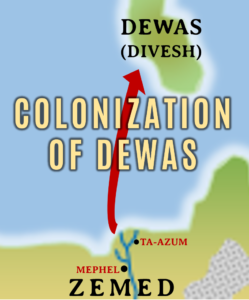 500 Colonization of Dewas. The Zemed drive the Razu into the uplands of Divesh. Gynosphinxes come with them, and their Shaman spawn minotaurs to guard their temples and tombs.
500 Colonization of Dewas. The Zemed drive the Razu into the uplands of Divesh. Gynosphinxes come with them, and their Shaman spawn minotaurs to guard their temples and tombs.
550 The Founding of Bussal. The dhaha Kupram of Nyupam sends Traders to Zasai, Tsobikapa, Vindha, and the Zemed colony on Dewas (Divesh).
To facilitate trade with friendly Asnam quasihumans, Kupram founds the port city of Bussal on the Asnam coast that would one day become known as Addaz.
600 The Song of Imfoi. This event is named for a famed song among the Adya, which records the conquest of the islands of Greater Imfoi and Lesser Imfoi by Warrior sailors from Yasayoi. The warlord Lazeka drove the giant octopus from the shores of the islands, and the tiger-men from the uplands, and built a legendary Stone Age kingdom with ties to Mijam, Zasai, and Tsobikapa.
650 The Last Dhahayate. Under resistance from Zhyndh and unfriendly Asnam, the dhaha Purál is depose by the dhaha Njuyam, who drives back the Zhyndh and Asnam, and establishes the Last Dhahayate of Nyupam. Damdalit Traders reach Mijam and Zemed for the first time.
700 The Middle Banua. A series of wars in Mijam result in the waha Zuduni conquering Mijam and expanding into Yaira and Ilomapa.
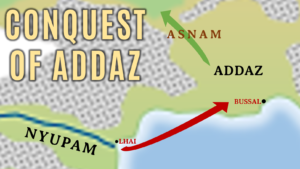 750 The Conquest of Addaz. In response to Trader colonies (in what would become Addaz) being constantly attacked by Zhyndh and unfriendly Asnam, armies are sent by the dhaha Kiman to Bussal to secure the coast, eventually driving the Asnam of the nearby meadowed uplands north into their forest homeland.
750 The Conquest of Addaz. In response to Trader colonies (in what would become Addaz) being constantly attacked by Zhyndh and unfriendly Asnam, armies are sent by the dhaha Kiman to Bussal to secure the coast, eventually driving the Asnam of the nearby meadowed uplands north into their forest homeland.
800 The Golden Age of Zasai. Under the allied wahas Byepa of Anjira and Lazwoye of Kaivai, the Zasai enter a prosperous age of building temples, forts, and public works which lasts 500 years.
Many of the great stone relics of the Adya were created during this age, including the Five Fire Staves of Wetawaia, the jeweled Eye of Lasuzni, and the Black Stone of Jabi.
 850 The Jali War. The Middle Banua waha Zichuni moves into the uplands of Mijam to fight herds of jali and the Spirit Folk of water.
850 The Jali War. The Middle Banua waha Zichuni moves into the uplands of Mijam to fight herds of jali and the Spirit Folk of water.
The Priestess Kuri brokers a truce in which the Mijam present offerings to the jali and Afa Spirit Folk in exchange for allowing farming and hunting villages in the uplands. This lives on as the jalifu folk religion among upland Mijam focused on the jali and Afa.
900 The Zemed Wars. This is a minor event in the history of Zemed, when the qatua Asemáyu sent pirates to disrupt the trade of rival peoples. But, for the Vindhan Yuta this was a brutal period that forced them to unite in a confederacy under the etun Ajipara of Taeya.
950 The End of the Dhahayate. After the dhaha Gurja imposes harsh taxes on Bussal and the other colonies of Nyupam, the dhaha Pandijam of Bussal revolts and establishes the independent kingdom of Addaz. This ends the Dhahayate of Nyupam, as the Damdalit people are thereafter divided.
Under their new dhahas, the Addaz people are separated from their religious roots in Nyupam and begin building their own elaborate temples.
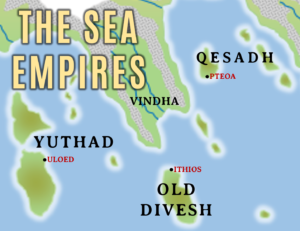 1000 The Sea Empires. The etuns Yudvi of Taeya and Lileto of Tadoma send colonists and warriors to dispel Zemed aggressors from Dewas/Divesh and establish new Trader ports.
1000 The Sea Empires. The etuns Yudvi of Taeya and Lileto of Tadoma send colonists and warriors to dispel Zemed aggressors from Dewas/Divesh and establish new Trader ports.
This is the beginning of the Sea Empires of Old Divesh, Qesadh (where the Tydhem now live), and Yuthad (where the Tudvam now live). The Qesadhi are the ancestors of the Yuta who eventually conquered Wesadhi, and the Yuthadi are the ancestors of the Inet.
The ancient library city of Ithios on Divesh is founded, as well as the fallen cities of Uloed on the Yuthadi island now known as Shattem and Pteoa on the Qesadhi island now known as Aftaia.
1050 The Second Zemed. A half-century after losing their Dewas colony, and under pressure from raids by Izakhez, the First Zemed kingdom falls and is replaced by the qatua Amyaghu, who establishes a new Zemed kingdom from his capital at Ta-Azum.
The Second Zemed establishes sea trade with the Sea Empires of the Yuta and with the Adya in Zasai, Yasayoi, and the islands of Tsobikapa that would become Wesadhi.
 1100 The Conquest of Inet. Invaders from the Sea Empire of Yuthad—the Tibi, Inati, and Hayn chiefs from ambitious families of Uloed—drive the Razu into the uplands of Inet, and eradicate them from Hyz, Naseati, Qitam, Hintashya, and Hiam.
1100 The Conquest of Inet. Invaders from the Sea Empire of Yuthad—the Tibi, Inati, and Hayn chiefs from ambitious families of Uloed—drive the Razu into the uplands of Inet, and eradicate them from Hyz, Naseati, Qitam, Hintashya, and Hiam.
The Tibi who invade Qitam fight vigorous wars under the yutan Sangamora against the Zhyndh that quickly results in the eradication of those humanoids.
1150 The Wars of Yoko. The Middle Banua waha Yoko conquers the islands of Jai, Yaira, Ilomapa, and Huaz in a string of brutal wars opposed by the Priests of the fox goddess Wetawaia.
This leads to a civil war in which Yoko is deposed by the waha Kimue, who keeps the provinces but promises to rule over them justly. The relic Horn Crown of Kimue, still worn by the waha of Mijam, was created at this time.
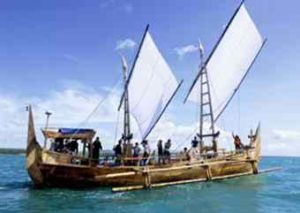 1200 The Exploration of the Far Islands. The Adya people of the Imfois, dedicated to the bird god Buruy, begin spreading into Vasefomoi, and the archipelagos of Zesam, Zivtoi, and Wasau. Many ancient songs from this age are still sung by the Poets of these Adya people.
1200 The Exploration of the Far Islands. The Adya people of the Imfois, dedicated to the bird god Buruy, begin spreading into Vasefomoi, and the archipelagos of Zesam, Zivtoi, and Wasau. Many ancient songs from this age are still sung by the Poets of these Adya people.
1250 The Divine Wars. Conflicts arise between the Priests of Agtile and Dajata in Zemed, and the Priests of Ashyu and Yathu in Vindha. The struggles feed into each other and threaten the rule of the various etuns of Etudwa and the qatua Muresh of Zemed.
The conflicts were suppressed by Scribes, who record the wars in histories that are very defamatory toward Priests. The relics of Agtile’s Obsidian Dagger and Yathu’s Club are created during these wars.
1300 The Chaos of Zasai. The city-states of early Zasai are plagued by raiders from Wesadhi and Yasayoi, leading to a complete collapse of civilization there. Many temples are abandoned and the people descend into a thousand-year age of warring chiefdoms which saw the construction of many legendary stone fortresses.
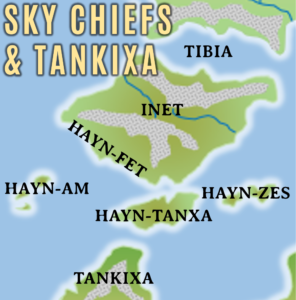 1400 The Sky Chiefs of Inet. These warlord yutans built the earthenwork pyramids and megalithic structures of Inet, and also built strong ties to the Spirit Folk.
1400 The Sky Chiefs of Inet. These warlord yutans built the earthenwork pyramids and megalithic structures of Inet, and also built strong ties to the Spirit Folk.
During this time, trade is reestablished with the Razu people of the uplands of Inet. The Sky Chiefs’ part in this is to build stone pools for the Razu to swim and keep fish in. These ancient pools are still central to the Razu villages in Inet.
1500 The Rise of Tankixa. Strongly influenced by the Sky Chiefs of Inet, the peoples of Zakhten and Aysay begin building earthen pyramids and megalithic structures. The lords and ladies of Tankixa begin using the Izakhez as political and trade emissaries to Zemed.
1900 THE BIRTH OF BRONZE. The Yuta in Vindha begin creating tools and weapons from bronze. At the same time, they learn to work gold and silver. This technology is quickly adopted by Old Divesh, but is resisted by the yutans of Wesadh and Yuthad.
The god Busvam is credited for granting this knowledge to the Priests of Vindha, reestablishing their preeminence against the Scribes, who had enjoyed a privileged status after the Divine Wars.
 2000 The Vindha Expansion into Tudvam and Tydhemia. The Bronze Age warlord etuns of Etudwa begin expanding to the east and west, driving the Stone Age people living in the Sea Empire of Yuthad (what is now Tudvam) into Inet lands, and driving the Stone Age people of the Sea Empire of Qesadh (what is now Tydhemia) to the seas.
2000 The Vindha Expansion into Tudvam and Tydhemia. The Bronze Age warlord etuns of Etudwa begin expanding to the east and west, driving the Stone Age people living in the Sea Empire of Yuthad (what is now Tudvam) into Inet lands, and driving the Stone Age people of the Sea Empire of Qesadh (what is now Tydhemia) to the seas.
There are also expeditions to Old Divesh, whose Warriors resist the invasion with Bronze Age weapons and the help of old Zemedi gynosphinxes and minotaurs. They adopt bronze tools as the conflict comes to a close.
2100 The Invasion of Wesadhi. Under pressure from invaders from Etudwa, the Yuta people of the Sea Empire of Qesadh adopt the Bronze Age technology early on from their Etudwa invaders (who would later become the Tydhem) and invade the Adya archipelago of Tsobikapa. They rename it Wesadhi, driving the native Kaba people into the uplands.
The Kaba people make alliances with the Metamhi and Tsote, and build eloborate villages of interlocking banyan trees.
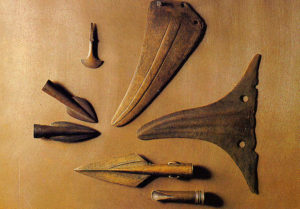 2150 The Damdilit Adoption. The peoples of Nyupam and Addaz adopt the technology of bronze from their Yuta neighbors.
2150 The Damdilit Adoption. The peoples of Nyupam and Addaz adopt the technology of bronze from their Yuta neighbors.
2200 The Conquest of Mewas. Bronze-armed Warriors from Addaz, under the dhaha Mevosa, brother of the dhahn Itaza of Bussal, invade the lands of the aggressive Zhyndh to the west. They set up the kingdom of Mewas and begin building temples in the Damdilit tradition.
2300 The Fall of the Sky Chiefs. A rebellion against Shaman dedicated to Ashyu and Yathu, with help from Yuthadi refugees, overthrows the Sky Chiefs and sends the Inet into a dark age. The Inet divide into coastal tribes, while the Razu reclaim much of the forested uplands.
 2350 The Zemed Adoption. The Second Kingdom of Zemed adopts the Bronze Age technology from the expanding Yuta.
2350 The Zemed Adoption. The Second Kingdom of Zemed adopts the Bronze Age technology from the expanding Yuta.
2400 The Third Zemed. Having lost their trading allies among the Sky Chiefs, and having their kingdom’s armies disrupted by Bronze Age weapons, the Zemed descend into a period of wars. The qatua Yupam of Mephel consolidates the valley in a new kingdom.
2500 The Rise of Kaivai. The people of Zasai rise out of their dark age with the help of Bronze Age tools to establish a confederacy of city-states led by the waha Drivípan city of Kaivai.
New temples are built, old temples are reclaimed, and trading ties are reestablished with Mijam, Yasayoi, Vindha, and the new Yuta rulers in Wesadhi.
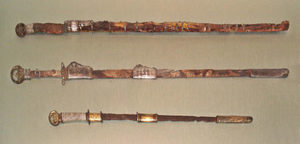 2600 The Late Banua. The waha Zotsinosho, having adopted Bronze Age weapons and aligned with upland farmers whose folk religion jalifu is under pressures from the sea cult of Hutiya, overthrows the Middle Banua of waha Pazazeye in Timyu and establishes a new banua in Kozo.
2600 The Late Banua. The waha Zotsinosho, having adopted Bronze Age weapons and aligned with upland farmers whose folk religion jalifu is under pressures from the sea cult of Hutiya, overthrows the Middle Banua of waha Pazazeye in Timyu and establishes a new banua in Kozo.
The culture of the Late Banua relies heavily on the traditional cult of Wetawaia, allied with the upland folk religion of the jali and Afa. The sea is seen as a resource to be exploited. The Priests of Hutiya evolve into a fisherman cult that reveres the waters primarily as a source of food.
The relics surviving from the wars of Zotsinosho include the Seven Swords of Fire (still held by provincial wahas), the Cloak of Jabi and the Pendant of Hutiya (rumored to be among Rogue clans), and the Bone Spear of Jabi.
2800 The Taking of Atzot. Yuta invaders from Awriya and Qitam eradicate the Zhyndh from the islands off the coast of Atzot and drive the Vyozah off the coast.
The settlements on the islands turn quickly to trade with Inet and Tudvam, but the coastal settlements continue to wage war against hostile Zitan.
2900 The Peace with the Asnam. The Damdilit of Addaz make peace with the Asnam and begin trading with them for mammoth ivory and lumber.
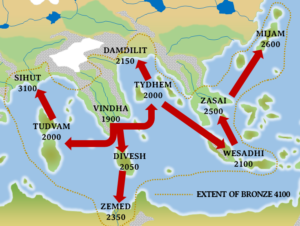 3100 The Landing at Zadas. The first Tudvam colony in Sihut is established at the beachhead that would later become the city of Zadas, beginning a push that drove the Cavern People of Vyozah and Hahmom from the coast.
3100 The Landing at Zadas. The first Tudvam colony in Sihut is established at the beachhead that would later become the city of Zadas, beginning a push that drove the Cavern People of Vyozah and Hahmom from the coast.
Many Sihut megalithic tombs for Warriors are built near the sites of ancient battles. These tombs house relics and undead monsters.
3000 The Voyage of Chadawin. An Addaz Scribe named Chadawin travels with Asnam guides into the north, to describe the forest of Asnam, the Great Ice, and the lands of the Sebilos and Himhet in the Chronicle of Chadawin.
3150 The Kaba Truce. The Wesadhi yutans establish ties with the Kaba people of the uplands, securing places for Kaba people in the Wesadhi cities, primarily as Rogues and Poets.
This marks the beginning of the trade in Kaba figs, widely recognized as the supreme strain of this fruit, used in many magical and religious ceremonies.
 3200 The Division of Tankixa. The city-states of Aysay unite in a loose confederacy under pressure from Tudvam pirates. This coalition forces the pirates to the west, taking up Inet Warriors into their ranks. These raids from the Inet cities of Nauhak and Hafeduya force the Zakhten to collaborate in defense under a sense of resentment against both the Tudvam and the Aysay.
3200 The Division of Tankixa. The city-states of Aysay unite in a loose confederacy under pressure from Tudvam pirates. This coalition forces the pirates to the west, taking up Inet Warriors into their ranks. These raids from the Inet cities of Nauhak and Hafeduya force the Zakhten to collaborate in defense under a sense of resentment against both the Tudvam and the Aysay.
This leads to the rise of the war god Adad in Tankixa, and the beginning of the relationship between Tankixa nobles and the hulqa lizard-birds.
3400 The Taking of Qiley and Zam. Colonists from Atzot settle the uninhabited islands of Qiley and Zam. They discover rich outcrops of Sitanum (tin) and begin trading it through the Inet.
3700 The Fourth Zemed. The qatua Gatoa of Ta-Azum establishes a new kingdom after the qatua Yiyamphaz dies without progeny.
3800 The Journey of Tibyera. A Sihut Scribe named Tibyera travels into Zitan lands and describes the lands of the Vyoazh, Hahmom, and Himhet in the Chronicle of Tibyera.
3850 The Islands Chronicle. A Zasai Poet named Nakat travels through Yasayoi, Nisa, Vava, and the Outer Islands, recording the histories and songs of these peoples in the Chronicle of the Islands.
3900 The Atlas of the West. A Scribe from the city of Tadoma named Usimios travels throughout the lands of the Inet, Atzot, and Qiley, recording his observations in the Chronicle of the West.
4000 The Travels of Xasifum. A Zemed Scribe named Xasifum journeys in the deserts of the Izakhez and along the Janis coast to the lands of the Avada, describing the landmarks, wildlife, and peoples in the Chronicle of Xasifum.
 4032 The Forging of the Bronze Crown. The etun Tezisid of the city-state of Taeya has his Priests create a magical crown. The powers of this relic are disputed, but they are dedicated to the Yuta lightning god Vrisha.
4032 The Forging of the Bronze Crown. The etun Tezisid of the city-state of Taeya has his Priests create a magical crown. The powers of this relic are disputed, but they are dedicated to the Yuta lightning god Vrisha.
4045 The Victory of Tadoma. The etun Tuzid of Tadoma conquers the other city-states of Vindha, takes the Bronze Crown of Taeya, and establishes an empire of the Etudwa people in Vindha.
4100 The Present Day. The Empire of the Bronze Crown is the primary power in the Bronze Age world. They have tense relations with the Tudvam and Tydhem, and carry out conquest raids into Divesh and Hallia. They have close ties with Zemed, Zasai, the Tankixa, and Sihut.
Mijam and Zasai enjoy an alliance against pirates from Yasayoi, who enjoy covert alliance with Rogue waha among the Mijam and Zasai, and the yutans of Wesadhi.
The Zemed maintain strong ties with Etudwa, Divesh, Zasai, Wesadhi, and the Tankixa through the Izakhez. They have tense relations with Tudvam and Tydhem, who still have strong pirate contingents among their sailors.
The Inet maintain trade (primarily in tin) from Atzot and Qiley to the Bronze Age civilizations of Zemed, Etudwa, Tudvam, Tydhem, and Zasai.
The Damdilit develop their civilization on the peripheries of Yuta civilization and the wilderness of the north.
The Scribes of Bronze Age civilizations organize conferences to consolidate knowledge about the world. Priests and Poets build ties to trade religious knowledge and songs. Rogues and Trackers build ties to carry out their often covert endeavors.
The Elders of Asnam connect with the Sorcerors of Sebilos, Himhet, Otovyi, and Zitan to protect their Stone Age ways from the incursions of Sihut, Damdilit, and Mijam.
